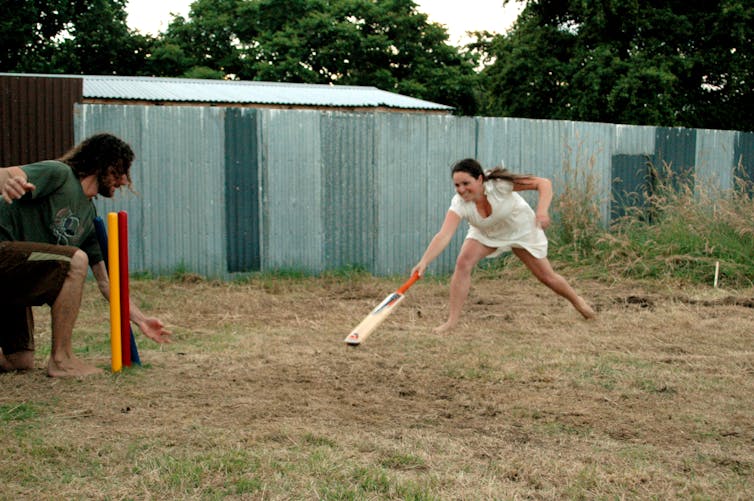Can the Big Bash League's backyard cricket bat flip truly be fair?
- Written by Stephen Woodcock, Senior Lecturer in Mathematics, University of Technology Sydney
Ahead of the start of the 2018-19 Big Bash League season comes news of a radical change that will bring a smile to the faces of backyard cricketers across the country.
In a move familiar to everyone who has ever improvised a set of stumps from a nearby wheelie bin or Esky, the coin toss is no more.
Instead, batting order will be decided by the tried-and-tested method of backyard cricketers everywhere: the bat flip.
 The coin toss was used by Adelaide Strikers captain Suzie Bates and Sydney Sixers captain Ellyse Perry before the Womens Big Bash League (WBBL) match in January this year.
AAP Image/Jeremy Ng
The coin toss was used by Adelaide Strikers captain Suzie Bates and Sydney Sixers captain Ellyse Perry before the Womens Big Bash League (WBBL) match in January this year.
AAP Image/Jeremy Ng
No more ‘heads’ or ‘tails’
Rather than calling “heads” or “tails”, team captains will be guessing if the bat will land with its flat side upwards (called “flats”) or downwards (“hills”).
Most seasoned veterans of backyard cricket tend to favour a call of “hills”, thinking that the bat will more likely roll over if it lands on its uneven side, compared with if it lands flat.
The Big Bash League’s Kim McConnie was confident that such predictability will not be an issue.
 Cricket Australia’s head of Big Bash League, Kim McConnie.
AAP Image/Dave Hunt
Cricket Australia’s head of Big Bash League, Kim McConnie.
AAP Image/Dave Hunt
She told the ABC that bat-maker Kookaburra had developed a special bat for this purpose:
You’d be surprised at the science that’s gone into this. It is a specially weighted bat to make sure that it is 50-50.
Despite such bold claims, it remains to be seen whether the bat flip will prove to be as unbiased once the season begins.
Howzat for fairness?
Even a standard coin, whose two sides are far more evenly weighted and shaped than any cricket bat, can never be said to be truly a 50-50 proposition.
The simple fact is that there is no such thing as a coin that is absolutely fair. Even a completely symmetrical coin could be biased towards one outcome - whether deliberately or otherwise – by the action of the person tossing the coin.
Some people’s technique will push the coin higher. Others might give the coin more rotation.
As US president Donald Trump recently (and strangely) demonstrated, some people have a style all of their own.
Call that a coin toss?In a 2009 study, researchers at the University of British Columbia concluded that even a regular coin could easily be made to produce biased outcomes when the person tossing it was told “how to manipulate the toss of a coin” and incentivised to make it so.
Of 13 participants, each flipping the coin 300 times, all managed to produce more heads than tails. Overall, of the 3,900 tosses, 57% landed heads. One participant was able to obtain heads more than twice as often as tails.
Put to the test
In the haphazard and improvised spirit of backyard cricket, I decided to see how a cricket bat would land when flipped. I, of course, did not have access to one of the new Big Bash League bats so had to make to with the old battered bat from the back of the garden shed.
With a nod to procedural fairness, I decided to try two different techniques: low rotation (aiming for two of three flips while in the area) and a high rotation (as many flips as I could manage). Each of these techniques was applied 100 times to the bat being flipped from “hills” up in my hands, and 100 times from “flats” up.
I’ll be the first to admit that this resembles serious scientific rigour about as much as the browning patch of grass next to your parents’ Hills Hoist resembles the MCG.
A greater sample size would have been preferable, but this was as much as I could muster in fading light in a suburban backyard.
Keeping score
Based solely on the results of my backyard testing, you can likely chalk this one up as a win for conventional wisdom.
Especially when the bat was flipped with high rotation, it appeared to exhibit bias towards landing “hills”: 68 times from a “flats” up and 63 times for “hills” up position.
For the less vigorous flipping technique, its initial orientation influenced the outcome more and the results were closer to 50-50: the “hills” 58 times from a “flats” up and 48 times for “hills” up position.
In fairness to the league and its equipment suppliers, I would imagine that the bats used will be a little less prone to bias than the one available to me.
Nonetheless, whatever results Kookaburra’s testing machine produced with its bat, it is difficult to believe that a large, asymmetrical bat will be less susceptible to bias by the flipper’s technique than a simpler, smaller coin.
Finishing off the tail
Even if the bat flip is indeed not as unbiased as confidently claimed, it probably doesn’t matter. The decision to ditch the coin flip for its more unconventional counterpart is not one driven by a desire for sporting equity.
It’s a move designed to further distance the loud, brash, big-slogging and brightly dressed T20 league from traditionalists’ cricket, and to generate hype for the forthcoming season. With all of the international headlines that followed the surprising announcement, the decision already appears to be a huge success for Australian cricket.
But don’t hold your breath for the “one hand, one bounce” rule or other classic backyard cricket innovations further infiltrating the Big Bash League.
 Backyard cricket rules: ‘No player can be dismissed first ball.’
Flickr/nemone, CC BY-NC
Backyard cricket rules: ‘No player can be dismissed first ball.’
Flickr/nemone, CC BY-NC
Authors: Stephen Woodcock, Senior Lecturer in Mathematics, University of Technology Sydney
Read more http://theconversation.com/can-the-big-bash-leagues-backyard-cricket-bat-flip-truly-be-fair-108601





